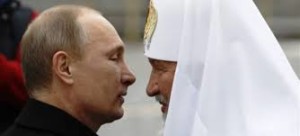
The newly established authoritarian regime in Russia has chosen to make the promotion of spirituality that is being served up as an intrinsic part of Russian culture and self-identification of the Russian nation as one of its priorities. It is obvious however that the regime’s real purpose consists in using this simple method to force its nationalist and patriotic rhetoric onto the population by glorifying the county’s past successes and inspiring pride in the “centuries-long history of the Russian empire” which in its turn allows the regime to draw the population’s attention away from the authorities’ lack of competence in governing the country and to cover up the most flagrant corruption by top Russian officials.
Responsible for spirituality, the Russian Orthodox Church (ROC) is formally separated from state institutions that, according to the law, are supposed to be secular by nature. However, ROC enjoys a number of economic advantages that have been granted to the Church during the Putin’s era. Thus, for example, it is impossible to use standards methods to calculate its “market capitalization” because legally, ROC is divided into more than 30,000 different organizations and since the mid-1990s it has not been disclosing either its gross budget or expenses. According to certain estimates, ROC’s income possibly reaches 5.6 billion rubles (or around $87 million) a year, without including federal funds that are being allocated annually to ROC and structures close to it which amount to another 3.5 billion rubles (or about $54 million). This does not seem such a large sum for a Church with more than 50 million faithful, does it?
However, this is only a part of the Church’s budget that different sources or ROC representatives themselves disclose from time to time in their statements. Meanwhile, it is hardly possible to estimate the Church’s real income generated through donations that are mostly made in cash. The alleged bribe in the amount of €150,000 received by Kirov Governor Nikita Belykh that, according to Novoya Gazeta’s sources, was supposed to be used to restore an Orthodox church can serve as a recent example illustrating this practice.
An article published by sociologist Nikolai Mitrokhin fifteen years ago sheds some light on the extent of discrepancies. In his article, Mitrokhin then estimated ROC’s annual income at around half a billion dollars. It is rather obvious that ROC’s income could hardly be lower during the 2000s when oil prices soared. It is also worth mentioning that ROC and structures close to it are the country’s major real estate owners and as religious associations are exempt from land tax and tax on property they use for religious purposes. It is not a secret that ROC’s properties including the Cathedral of Christ the Savior, a colossal modern replica of the original church built, among other, with “voluntary” donations collected from Moscow commercial structures, are being widely used for commercial purposes.
We have until now been talking about the revenue part of ROC’s budget. Even less is known about ROC’s expenditures. Indirect indications help establishing on what exactly church funds are being spent besides construction and restoration of churches. Thus, ROC’s expenditures include for example Patriarch Kirill’s recent Latin America tour on board an aircraft of the special air squadron Rossiya that comes under the jurisdiction of the tsar’s court that is the Executive Office of the President (pardon the slip of the tongue) or Patriarch’s trip to a penguin rookery in Antarctica. The combined cost of air travel only during these two trips probably reached about one-third of a million dollars. It is fair to say that it is unclear whether the Russian Orthodox Church paid for these trips or the lonely Patriarch treated himself to a nice holiday at the expense of Russian taxpayers.
Other infamous stories featuring the head of the Russian Orthodox Church include his Breguet watch; his lavish apartment located in one of Moscow’s most prestigious buildings, House on the Embankment, across the Moscow River from the Kremlin; his mansion-like dacha situated in a nature reserve on the Black sea coast; his $4 million yacht allegedly presented to him by Putin; and his luxury cars. The list can obviously go on, and this is only one hierarch at the ROC’s helm. How many more of his colleagues are not willing to content themselves with an ascetic life? “There is no need to disclose the Russian Orthodox Church’s expenditures insofar as it is absolutely clear that the Church spends its money on church needs”, such was chairman of the Synodal Department for the Cooperation of the Church and Society of the Moscow Patriarchate, Vladimir Legoida’s laconic answer to this rhetorical question.
 There is no doubt that this answer satisfies the tsar, otherwise new criminal cases on corruption charges against top-ranking representatives of the Russian Orthodox Church would be initiated daily by the dozen. The only people who are not happy about this situation are those few civil activists who understand how many hospitals, rehabilitation centers and day care centers could be built or renovated with the federal funds spent on church “needs” and the profit tax ROC fails to pay.
There is no doubt that this answer satisfies the tsar, otherwise new criminal cases on corruption charges against top-ranking representatives of the Russian Orthodox Church would be initiated daily by the dozen. The only people who are not happy about this situation are those few civil activists who understand how many hospitals, rehabilitation centers and day care centers could be built or renovated with the federal funds spent on church “needs” and the profit tax ROC fails to pay.





